Most board games include an attempt—often in the rulebook—to tell a story. Some travel that extra mile to craft one or several worlds of depth and circumstance in which the game takes creative shape. Still others include a tricked-out digital app to narrate said story complete with a bevy of accents and sound effects alongside a mood-inducing musical score.
Only one that I’ve seen includes a quirky micro-comic about the occasional annoyances of receiving the diplomatic gift of a very hungry panda.
Takenoko, the ten-years-young creation of Antoine Bauza (7 Wonders, Tokaido, Draftosaurus), tells just such a story, dropping folks into the charming scene of a Japanese imperial bamboo garden. The gardener, rather than experiencing the tranquility of his labors, must contend with an adorable oversized eating machine.
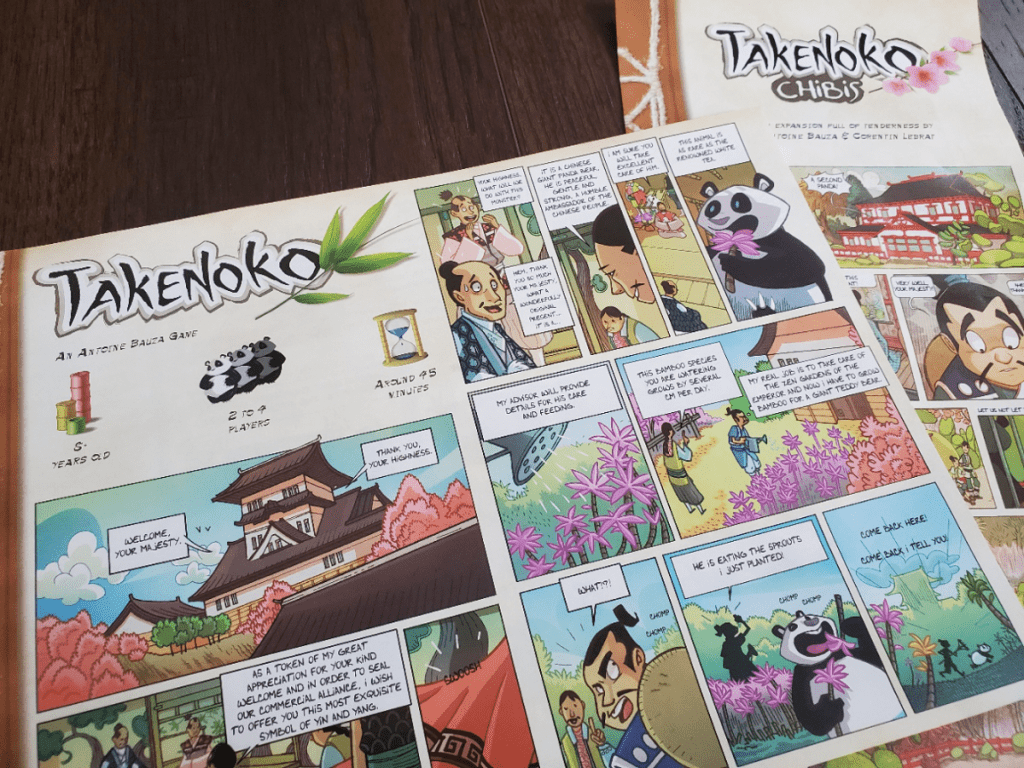
In this now-classic selection from Bombyx Games, players attempt to juggle the arrangement and growth of a beautiful bamboo garden while satiating the voracious appetite of a giant panda. The Chibis expansion even adds a mate and a burgeoning family for everyone’s favorite black and white critter. All that’s missing is the giant panda cam livestream.
The comic beginning sets the stage for a light-hearted, charming experience that might even inspire related haiku. Does it deliver? I believe it does.
“Bamboo sprout”
During setup, personal boards are passed around for storing various items and marking out selected actions. The pond tile is placed at the center of the table to ready the garden while the Gardener and Panda figures stand in the water, presumably to cool their ankles.
Players have their eyes on three tasks throughout the game. These are laid out as three separate piles of Objective cards. Players receive one card of each type at the outset to spark fruitful creativity in the garden and set the path toward victory points:
- Arranging Plots by placing hex tiles adjacent to the existing garden
- Irrigating land by laying water channels from the central pond
- Growing 3D Bamboo shoots on irrigated plots so that the cutesy panda can feast away

On each turn, players begin by rolling a weather die and applying its effects, which amount to some sort of meteorological blessing: a sunny bonus action, the rain-soaked growth of bamboo, a windy duplicate action, a lightning-quick bamboo snack for the panda, cloudy land improvement tokens, or a wild.
Typically, players then take two different actions from the five possibilities:
- Draw three Plot tiles and place one into the garden
- Claim one Irrigation channel, using it immediately or saving it for later
- Move the Gardener to a different plot to grow bamboo
- Move the Panda to a different plot to eat a section of bamboo
- Claim one Objective card from the deck of choice
There are a number of quirks that accompany these actions to both aid and hinder would-be zen gardeners. The Gardener and the Panda must move along straight lines, which in a hex-tiled garden means not every tile is available at any given moment. The Gardener’s work is effective not only on his landing tile, but on every adjacent tile of a matching color. Land improvements include Enclosures which forbid panda snacking, Fertilizer which doubles growth, and Watershed which provides irrigation without a connection to the pond. These can be placed at any time to alter the garden’s behavior.
If after taking their actions the player has completed any of their Objective cards, they may lay them down as complete. The game continues in this fashion until a specific number of Objectives have been met based on the player count. The first to reach this count receives a small blessing of points from the Emperor as scoring ensues. Scoring is then entirely in the value of completed Objective cards.
If there is a tie, the player who best fed the panda is named the winner.
“Small”
The Chibis expansion introduces Miss Panda to further frustrate and interfere with the Gardener’s efforts. Or does she? As it turns out, the female is not all that hungry for bamboo. When she is moved to land on a Plot with the Panda, rather than eating, players claim a Baby token from the supply that matches the color of the tile. Each of the limited number of Baby tokens carries victory points and grants either an Irrigation token, Improvement token, or the ability to trade an Objective card back into its deck.
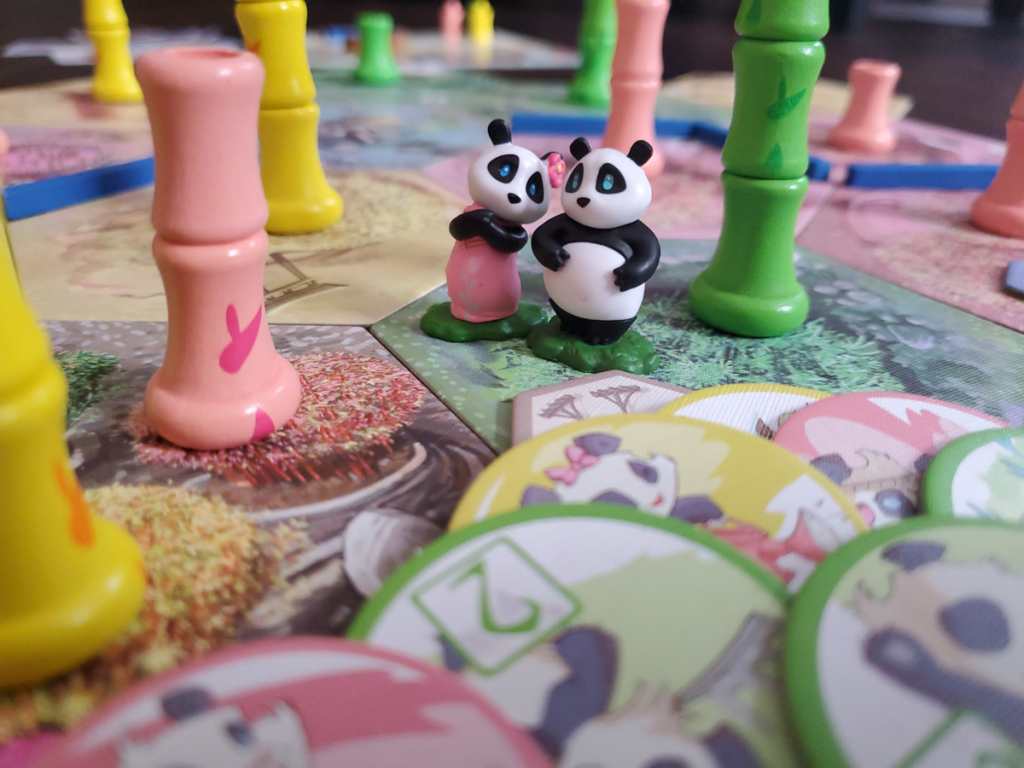
On the more seamless side, Chibis also introduces a number of unique tiles to the garden that result in a season of abundance. A second Pond allows for easier irrigation. Kamis tiles grow all three colors of bamboo, creating endless opportunities for every type of Objective. Sacred hills spark growth for every tile of a specific color across the garden, regardless of location. The Gardener’s hut allows for more variety and control in Objective card selection.
Through the additions to the Panda family, Chibis adds a wholly new avenue for scoring. Through the garden enhancements, the expansion puts the land on anabolic steroids, sprouting bamboo almost uncontrollably; and with the Panda being distracted, he doesn’t eat nearly as often. The poor gardener must be at wit’s end! Is there no end to this unbearable madness?!
Everyone knows that sometimes expansions are not the best idea. Chibis is by no means essential, but it provides an opportunity to explore a wild What If… scenario while gently nudging some of the game’s features. I found it to be a refreshing twist to a game we already enjoy.
“Kangae”
Takenoko, from top to bottom, is visually arresting on the table. The tiles are a beautiful blend of green, pink, and yellow with vertically sectioned wooden bamboo shoots to match. The garden grows wildly from its small beginnings in the pond to engulf the table in a landscape of color. The cards adopt shades of blue, red, and purple to add a spectrum of splashes all over the place. The game even includes two utterly useless but delightful panda tiles to lay out for style. The Gardener and the Panda are painted minis of the characters from the comic. Regardless of game outcomes, it is impossible to walk away from a session without admiring the aesthetics. In fact, you’ll likely be inclined at some point during the game to snap a pic of the garden.
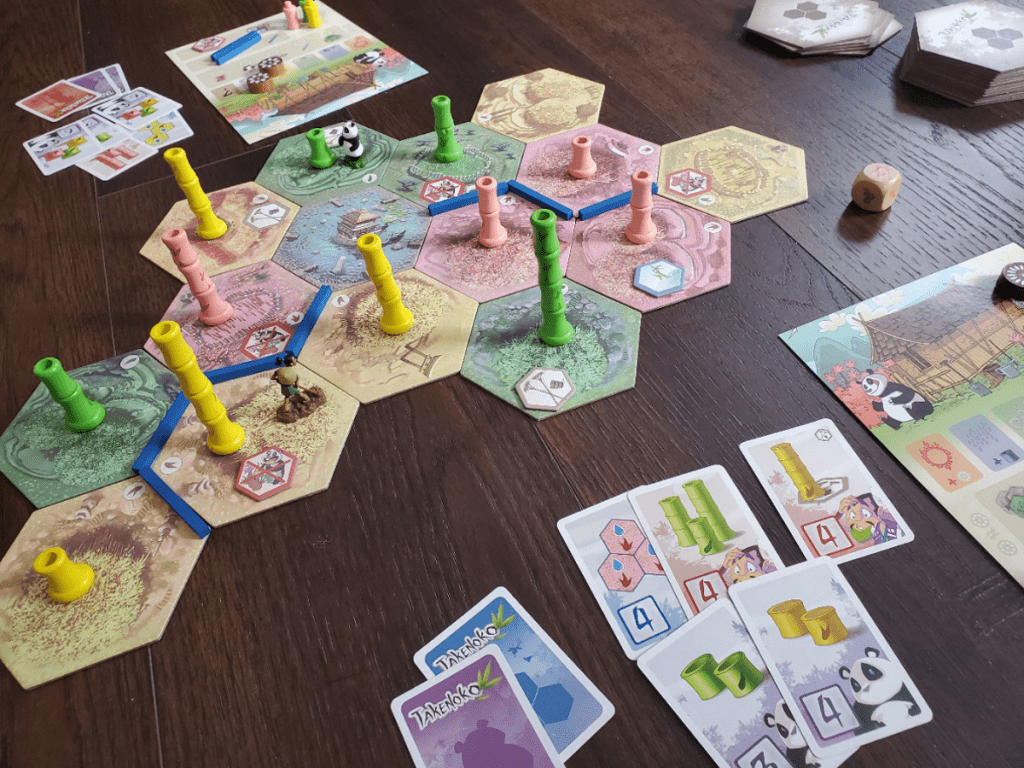
I already mentioned the comic, but I have to revisit the concept, because Takenoko boasts one of my favorite rulebooks. It is the only book in our collection that the kids fight over when the game opens. The illustrations are sweet and humorous, and they immediately draw players into the game’s narrative. Throughout the book, the gardener’s frustration comes alive as he teaches the rules and wrestles his enormous cuddly friend. Theme goes a long way in winning me over, and these characters have personality.
The base game of Takenoko is a gem. At two players the pace is frantic, which often limits decisions in the Objective cards on the fast track to nine cards. Three and four players spread the garden wide and allow for more selectivity and lucrative scoring, despite reducing the endgame threshold to eight and then seven cards.
On the more critical side, any game that features no-fault contract cards is prone to dumpster diving. In practice, this means spending turns at the end of the game desperately collecting random Objective cards—rather than taking fruitful turns, mind you—in an attempt to happen upon conditions that already exist to quickly scavenge points. Takenoko would not be harmed by penalizing cards in hand at the game’s end, but neither is the dirty diving so troublesome that it alters the outcome. If desperation is the only remaining play, then perhaps fate has already sealed the outcome for at least one seat at the table.
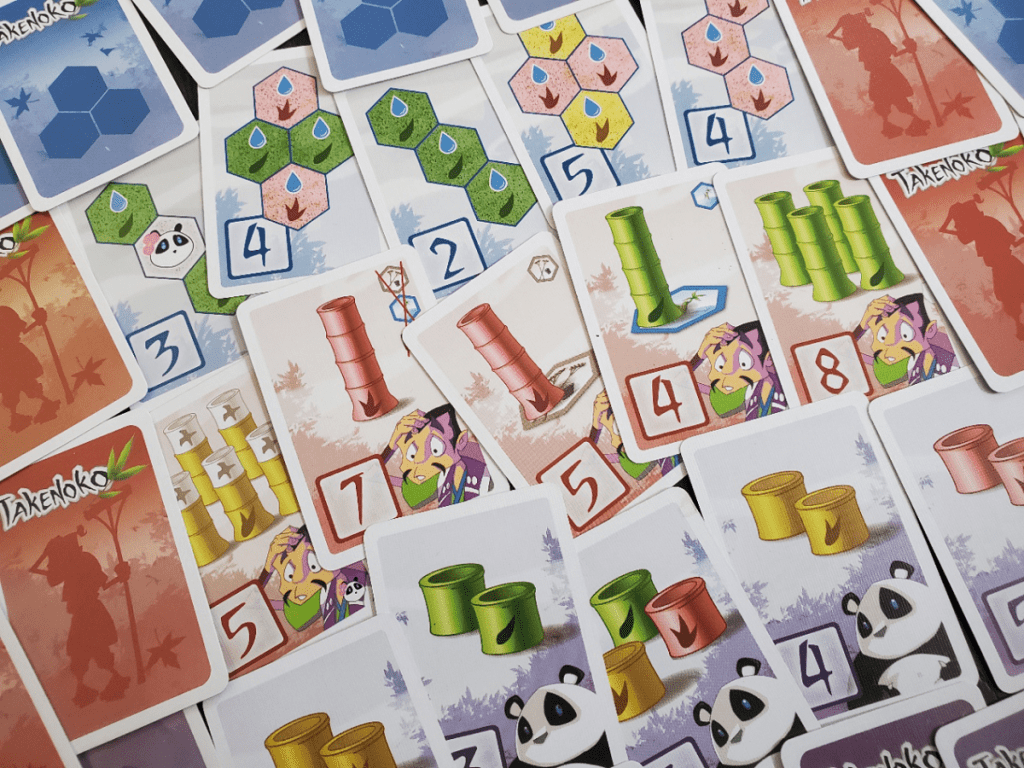
Over the years, there have been a number of comments hovering in the atmosphere about the distribution of points on the Objective cards. The base game favors feeding the panda over all others—especially Plot cards—which can frustrate those who love to chase balance, though I never really thought the imbalance broke the game. Chibis introduces two rule variants that quite brilliantly bridge the gap toward universal happiness. One suggests forbidding the Panda to feed on the base segments of bamboo sprouts, which provides a few hiccups to a strategy of dedicated gorging. The second grants a bonus for each complete set of three Objective cards, suddenly making those previously persnickety Plot cards quite important. Though the expansion was a recent addition to our collection, this second rule mod has been in play since we first heard of it, in part because I love rewarding balanced play.
The addition of a slew of Panda babies certainly changes the physical landscape of the game, but the new scoring avenue lays only a fixed number of available points on the table that occasionally prove to be the best action without stunting garden rhythms. All it takes is one attempt at my eight-year-old’s Babies, Babies, and all the Babies strategy to realize that victory does not await those who disregard the base game to love on the expansion material.
If you frequent BoardGameGeek (BGG), you know that every game page features a list of the game’s mechanics. Dice rolling, tile placement, set collection, and other tabletop terms help to depict the gameplay experience for experienced hobbyists. Takenoko features a whopping eleven mechanisms. Eleven! There is a surprising amount going on in this lively garden, but not in such a way that it overwhelms. The mechanics fit the theme beautifully, and I find in it all the relaxation the comic Gardener seems to desire!
The broad but lightweight collection of mechanics makes Takenoko a wonderful gateway game—a title that is fit for introducing young and new gamers to the ins and outs of the hobby without setting their thinking caps ablaze. From opening the box to scanning the finished product, Takenoko dips the player’s toes in the pond of what is possible in the heavier fare with modular maps, changing landscapes, resource management, and a few enjoyable low-consequence decisions. This is a game that suggests there is more to be done in tabletop gaming.

Despite ten years and thousands more competing titles, I would still say Takenoko is a peach of a family-weight game. Theme, aesthetic, and gameplay are in clever cahoots to create a playful and memorably immersive experience. Like so many Bauza designs, Takenoko is relatively stress-free fun whose greatest gift is time together in another world without ever leaving the dining room.


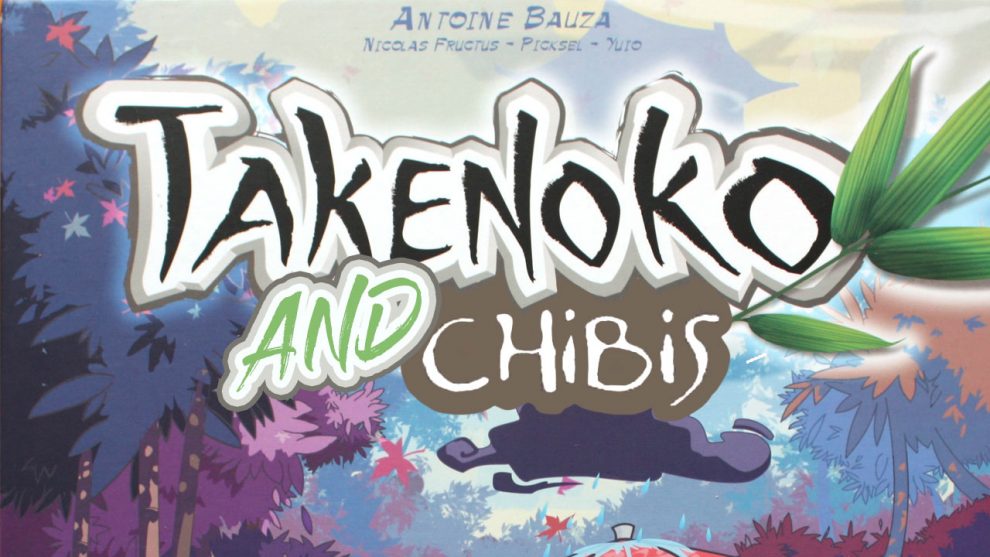









Add Comment